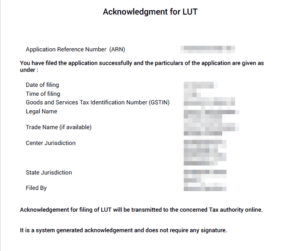LUT in GST
A Letter of Undertaking (LUT) under the Goods and Services Tax (GST) framework is a crucial document for exporters in India, allowing them to export goods and services without the upfront payment of Integrated Goods and Services Tax (IGST). This mechanism facilitates smoother international trade by alleviating the cash flow burden on exporters. Streamline Your Exports, Grow Your Business – File LUT in GST Now!
Request for Call Back
- All India Service
- Easy Onlie Process
- 24*7 Hours Customer Support
LUT in GST: Understanding the Concept
A Letter of Undertaking (LUT) is an important document for exporters in the Goods and Services Tax (GST) framework. It enables them to export goods and services without having to pay the Integrated Goods and Services Tax (IGST) upfront, resulting in significant cash flow benefits and increased global market competitiveness.
What is LUT in GST?
A LUT is a declaration made by exporters to tax authorities indicating that they intend to export goods or services without paying IGST. This facility is available to all registered taxpayers who have not been prosecuted for tax evasion over ₹2.5 crore under the CGST or IGST laws. The LUT must be filed prior to the export of goods or services and serves as a commitment to follow GST regulations and pay tax liabilities later.
Validity of LUT (Letter of Undertaking)
An LUT remains valid for current financial year from the date of its submission. Example- If LUT was furnished in FY 2023-2024, then the date of expiry of the validity of such LUT is 31st March 2024. Therefore, you need to file fresh LUT for FY 2023-2024.
If the goods for export are not exported within three months of Date of Invoice issue, then the Exporter is liable to pay GST along with 18% interest within 15 days according to Section 50 (1). Also in case of payment for services are not received within one year for which the LUT has been submitted, the exporter is liable to pay GST @ 18% within 15 days. Failing to do so will lead to withdrawal of LUT facility and on subsequent payments, it can again be restored.
Benefits of LUT in GST?
1. Tax-Free Exports
By opting for an LUT, exporters can carry out their export transactions without the immediate burden of Integrated Goods and Services Tax (IGST) payments. This exemption allows exporters to avoid the lengthy process of paying taxes upfront and then claiming refunds, which can strain cash flow and resources.
2. Improved Cash Flow
Because exporters are not required to pay taxes at the time of export, their working capital is unblocked. This liquidity can be critical for day-to-day operations, expansion plans, or reinvestment in the business, especially for small and medium-sized enterprises (SMEs) with limited funds.
3. Increased Competitiveness
Exports become more appealing to foreign buyers when they are GST-free, allowing exporters to price their goods more competitively in the international market. This can lead to increased sales and market share.
4. Legal Assurance
Submitting a LUT ensures compliance with GST regulations, which helps to avoid future penalties or legal complications. It serves as a legally binding commitment that builds trust between exporters and tax authorities.
Documents Required for LUT in GST
- GST User id and Password
- Pan card of 2 Witness
- Adhaar card of 2 Witness
- Occuptation of Both Witness
- Cancel Cheque of Entity
- Copy of Last Filed LUT (if any)

Validity of LUT (Letter of Undertaking)
An LUT remains valid for current financial year from the date of its submission. Example- If LUT was furnished in FY 2023-2024, then the date of expiry of the validity of such LUT is 31st March 2024. Therefore, you need to file fresh LUT for FY 2023-2024.
If the goods for export are not exported within three months of Date of Invoice issue, then the Exporter is liable to pay GST along with 18% interest within 15 days according to Section 50 (1). Also in case of payment for services are not received within one year for which the LUT has been submitted, the exporter is liable to pay GST @ 18% within 15 days. Failing to do so will lead to withdrawal of LUT facility and on subsequent payments, it can again be restore.
Important Point To Remember for filing of LUT
- An LUT remains valid for current financial year from the date of its submission. Example- If LUT was furnished in FY 2023-2024, then the date of expiry of the validity of such LUT is 31st March 2024. Therefore, you need to file fresh LUT for FY 2024-2025.
- NO bank guarantee required in case of letter of undertaking in GST.
- The LUT must be duly applied and signed by the authorised signatory of the company, firm, etc.
FAQ on LUT in GST
A Letter of Undertaking (LUT) is a formal declaration submitted by exporters to the GST authorities. It allows them to export goods or services without having to pay Integrated Goods and Services Tax (IGST) at the time of supply.
Any registered taxpayer engaged in the export of goods or services can file an LUT, provided they meet certain eligibility criteria. This includes exporters who wish to avoid paying IGST on their exports.
To be eligible for filing an LUT, exporters must:
- Be a registered taxpayer under GST.
- Be engaged in the export of goods or services.
- Have no pending tax liabilities or arrears.
- Maintain a satisfactory compliance track record, including timely filing of GST returns.
- A cover letter requesting the LUT, signed by an authorized person.
- Details of two independent witnesses.
- Any previously approved LUTs (if applicable).
An LUT is valid for one financial year. Exporters must renew their LUT annually if they wish to continue exporting without paying IGST.
If you do not file an LUT before exporting, you may be liable to pay the full amount of IGST along with potential penalties, which can be up to 100% of the IGST that should have been paid.
Yes, it is advisable to mention the LUT number on invoices related to exports made under the Letter of Undertaking to ensure compliance and facilitate processing.
If your application is rejected, you will receive a notice explaining the reasons for rejection. You may then address these issues and reapply.
